JEEP CHEROKEE 2020 Owner handbook (in English)
Manufacturer: JEEP, Model Year: 2020, Model line: CHEROKEE, Model: JEEP CHEROKEE 2020Pages: 332, PDF Size: 8.87 MB
Page 201 of 332
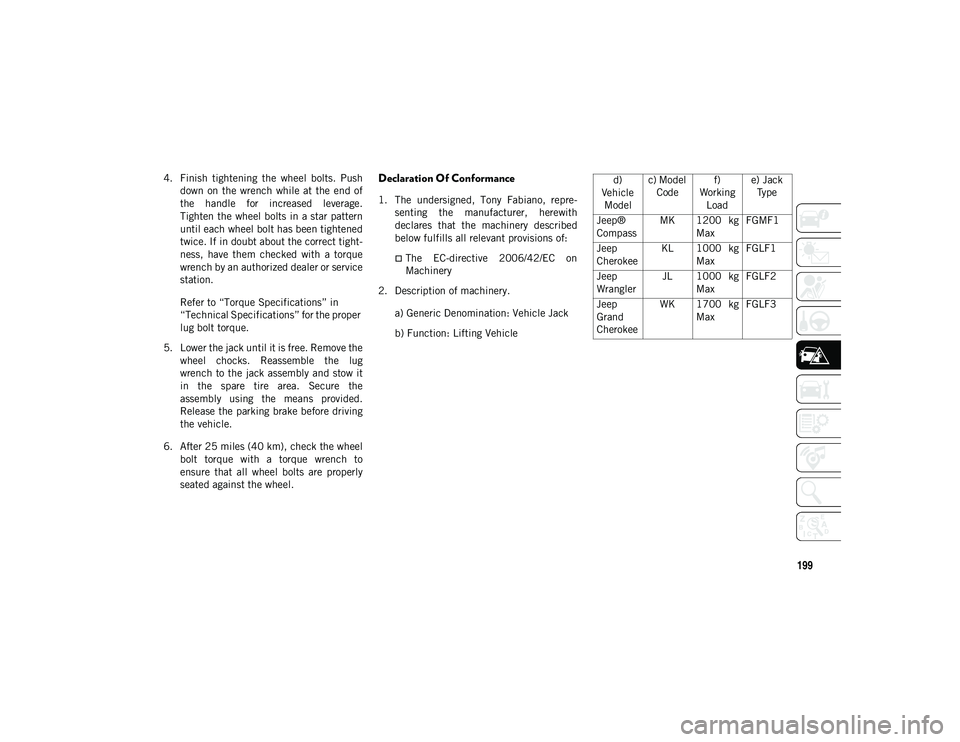
199
4. Finish tightening the wheel bolts. Pushdown on the wrench while at the end of
the handle for increased leverage.
Tighten the wheel bolts in a star pattern
until each wheel bolt has been tightened
twice. If in doubt about the correct tight -
ness, have them checked with a torque
wrench by an authorized dealer or service
station.
Refer to “Torque Specifications” in
“Technical Specifications” for the proper
lug bolt torque.
5. Lower the jack until it is free. Remove the wheel chocks. Reassemble the lug
wrench to the jack assembly and stow it
in the spare tire area. Secure the
assembly using the means provided.
Release the parking brake before driving
the vehicle.
6. After 25 miles (40 km), check the wheel bolt torque with a torque wrench to
ensure that all wheel bolts are properly
seated against the wheel.Declaration Of Conformance
1. The undersigned, Tony Fabiano, repre -
senting the manufacturer, herewith
declares that the machinery described
below fulfills all relevant provisions of:
The EC-directive 2006/42/EC on
Machinery
2. Description of machinery.
a) Generic Denomination: Vehicle Jack
b) Function: Lifting Vehicle d)
Vehicle Model c) Model
Code f)
Working Load e) Jack
Type
Jeep®
Compass MK 1200 kg
Max FGMF1
Jeep
Cherokee KL 1000 kg
Max FGLF1
Jeep
Wrangler JL 1000 kg
Max FGLF2
Jeep
Grand
Cherokee WK 1700 kg
Max FGLF3
2020_JEEP_CHEROKEE_UG_RHD_UK.book Page 199
Page 202 of 332
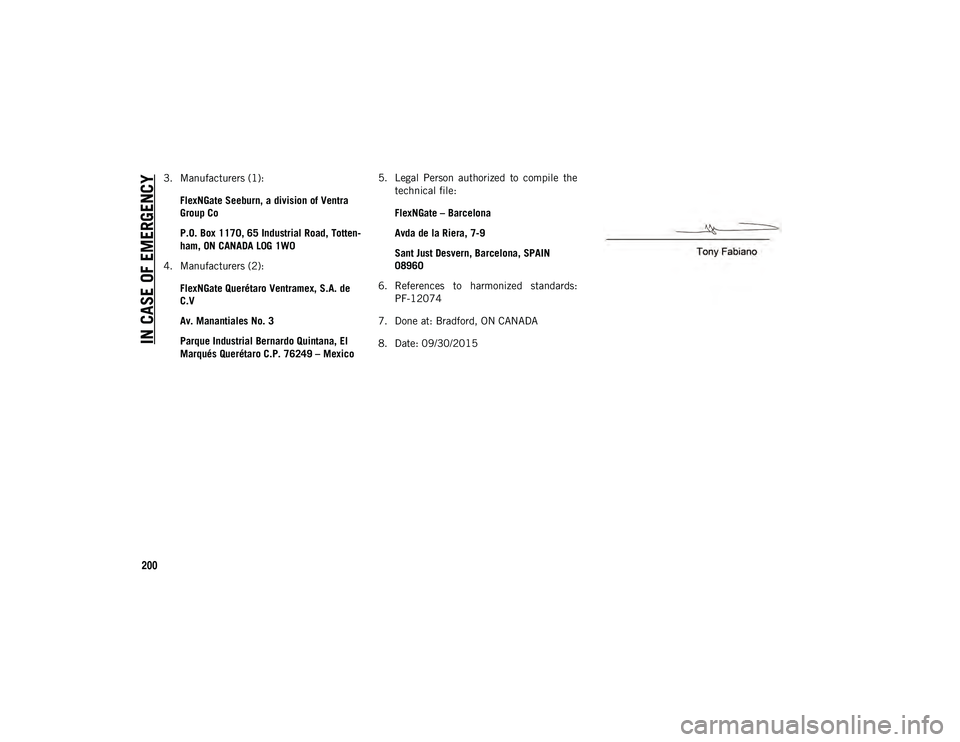
IN CASE OF EMERGENCY
200
3. Manufacturers (1):FlexNGate Seeburn, a division of Ventra
Group Co
P.O. Box 1170, 65 Industrial Road, Totten -
ham, ON CANADA L0G 1W0
4. Manufacturers (2):
FlexNGate Querétaro Ventramex, S.A. de
C.V
Av. Manantiales No. 3
Parque Industrial Bernardo Quintana, El
Marqués Querétaro C.P. 76249 – Mexico 5. Legal Person authorized to compile the
technical file:
FlexNGate – Barcelona
Avda de la Riera, 7-9
Sant Just Desvern, Barcelona, SPAIN
08960
6. References to harmonized standards: PF-12074
7. Done at: Bradford, ON CANADA
8. Date: 09/30/2015
2020_JEEP_CHEROKEE_UG_RHD_UK.book Page 200
Page 203 of 332
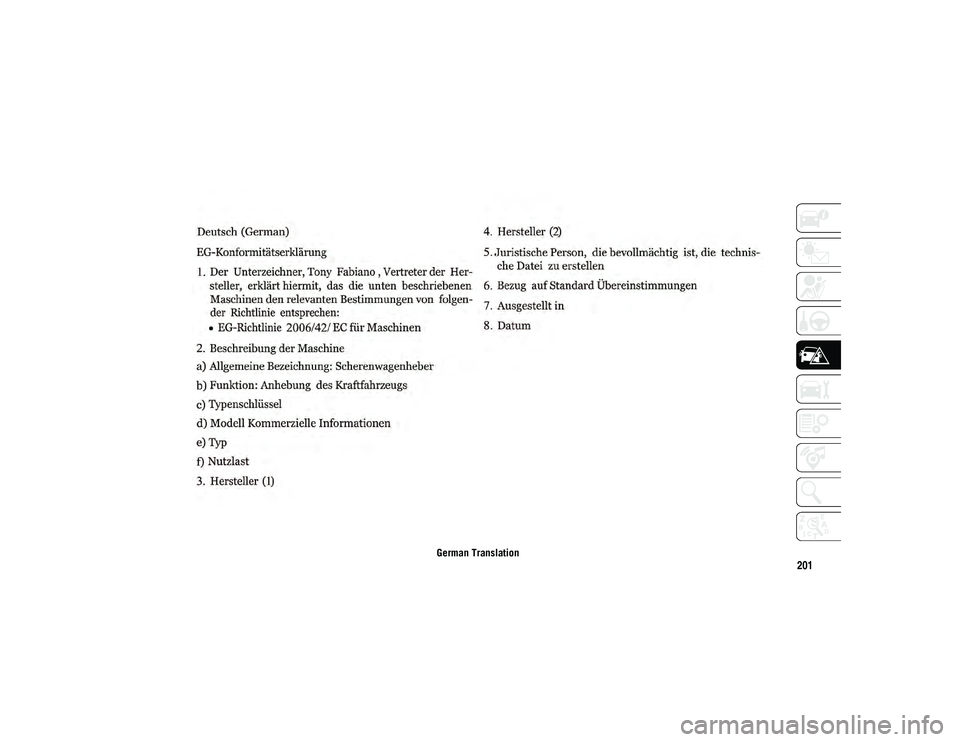
201
German Translation
2020_JEEP_CHEROKEE_UG_RHD_UK.book Page 201
Page 204 of 332
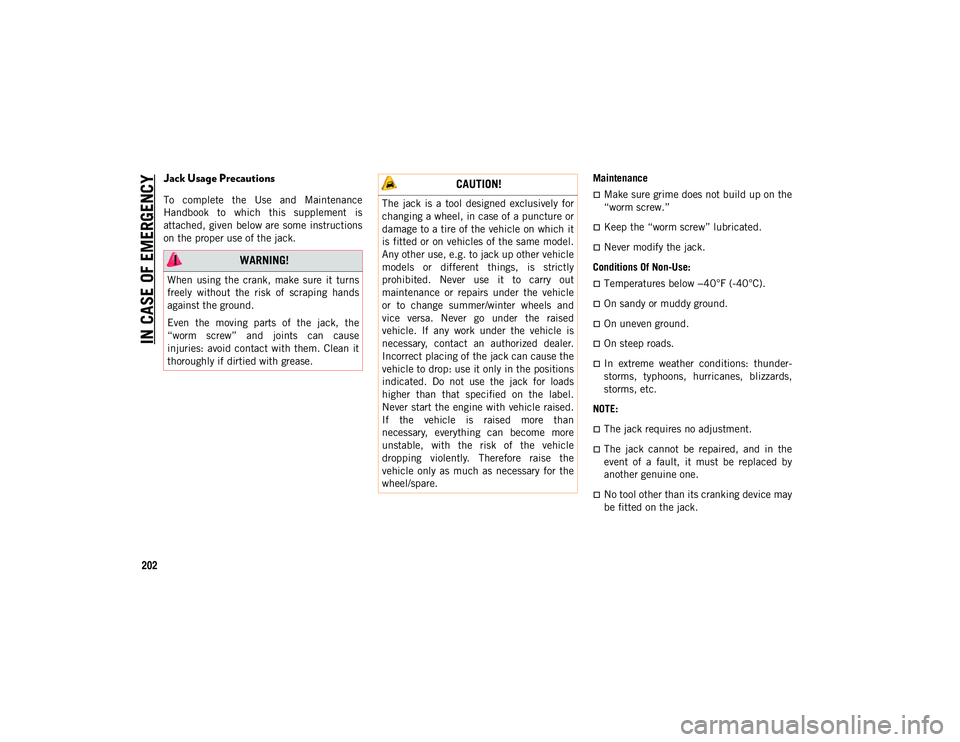
IN CASE OF EMERGENCY
202
Jack Usage Precautions
To complete the Use and Maintenance
Handbook to which this supplement is
attached, given below are some instructions
on the proper use of the jack.MaintenanceMake sure grime does not build up on the
“worm screw.”
Keep the “worm screw” lubricated.
Never modify the jack.
Conditions Of Non-Use:
Temperatures below −40°F (-40°C).
On sandy or muddy ground.
On uneven ground.
On steep roads.
In extreme weather conditions: thunder -
storms, typhoons, hurricanes, blizzards,
storms, etc.
NOTE:
The jack requires no adjustment.
The jack cannot be repaired, and in the
event of a fault, it must be replaced by
another genuine one.
No tool other than its cranking device may
be fitted on the jack.
WARNING!
When using the crank, make sure it turns
freely without the risk of scraping hands
against the ground.
Even the moving parts of the jack, the
“worm screw” and joints can cause
injuries: avoid contact with them. Clean it
thoroughly if dirtied with grease.
CAUTION!
The jack is a tool designed exclusively for
changing a wheel, in case of a puncture or
damage to a tire of the vehicle on which it
is fitted or on vehicles of the same model.
Any other use, e.g. to jack up other vehicle
models or different things, is strictly
prohibited. Never use it to carry out
maintenance or repairs under the vehicle
or to change summer/winter wheels and
vice versa. Never go under the raised
vehicle. If any work under the vehicle is
necessary, contact an authorized dealer.
Incorrect placing of the jack can cause the
vehicle to drop: use it only in the positions
indicated. Do not use the jack for loads
higher than that specified on the label.
Never start the engine with vehicle raised.
If the vehicle is raised more than
necessary, everything can become more
unstable, with the risk of the vehicle
dropping violently. Therefore raise the
vehicle only as much as necessary for the
wheel/spare.
2020_JEEP_CHEROKEE_UG_RHD_UK.book Page 202
Page 205 of 332
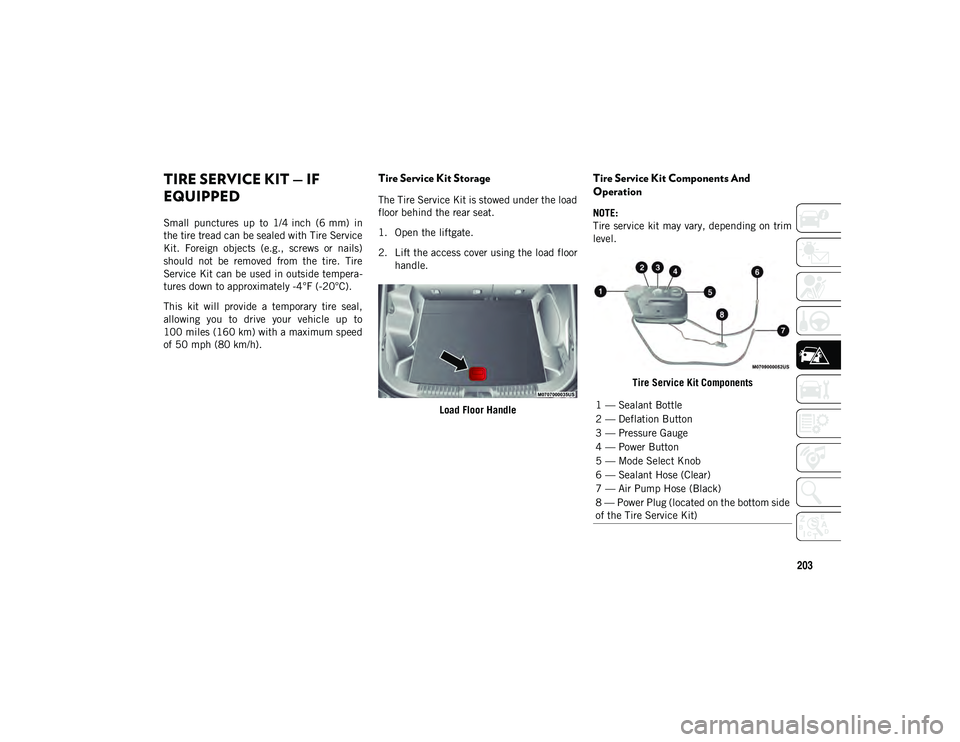
203
TIRE SERVICE KIT — IF
EQUIPPED
Small punctures up to 1/4 inch (6 mm) in
the tire tread can be sealed with Tire Service
Kit. Foreign objects (e.g., screws or nails)
should not be removed from the tire. Tire
Service Kit can be used in outside tempera-
tures down to approximately -4°F (-20°C).
This kit will provide a temporary tire seal,
allowing you to drive your vehicle up to
100 miles (160 km) with a maximum speed
of 50 mph (80 km/h).
Tire Service Kit Storage
The Tire Service Kit is stowed under the load
floor behind the rear seat.
1. Open the liftgate.
2. Lift the access cover using the load floor handle.
Load Floor Handle
Tire Service Kit Components And
Operation
NOTE:
Tire service kit may vary, depending on trim
level.Tire Service Kit Components
1 — Sealant Bottle
2 — Deflation Button
3 — Pressure Gauge
4 — Power Button
5 — Mode Select Knob
6 — Sealant Hose (Clear)
7 — Air Pump Hose (Black)
8 — Power Plug (located on the bottom side
of the Tire Service Kit)
2020_JEEP_CHEROKEE_UG_RHD_UK.book Page 203
Page 206 of 332
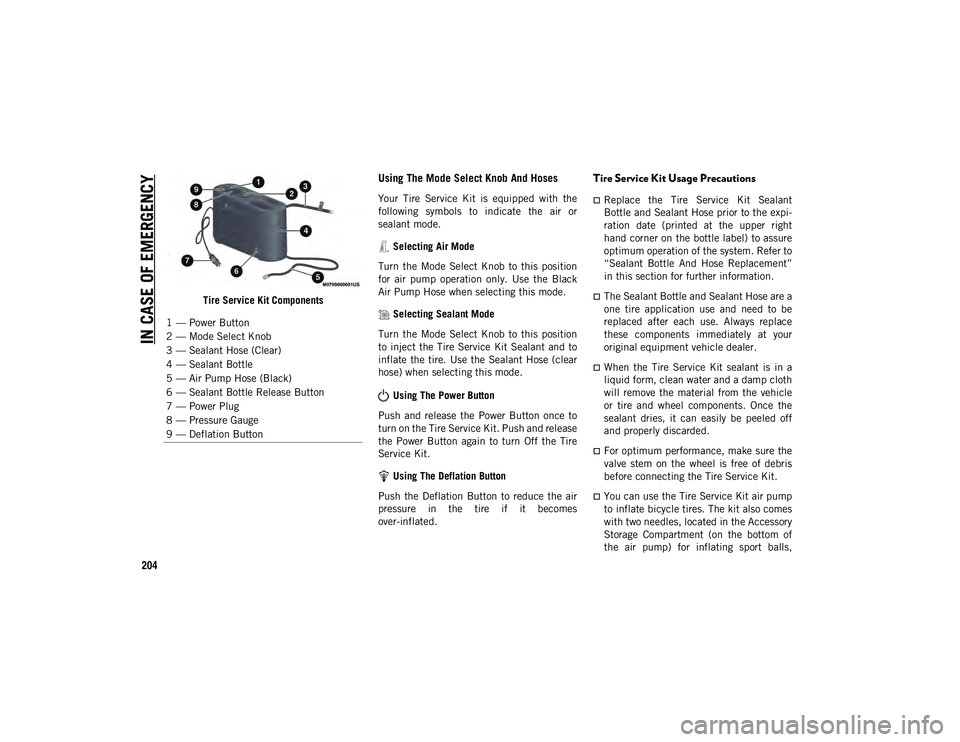
IN CASE OF EMERGENCY
204
Tire Service Kit Components
Using The Mode Select Knob And Hoses
Your Tire Service Kit is equipped with the
following symbols to indicate the air or
sealant mode. Selecting Air Mode
Turn the Mode Select Knob to this position
for air pump operation only. Use the Black
Air Pump Hose when selecting this mode.
Selecting Sealant Mode
Turn the Mode Select Knob to this position
to inject the Tire Service Kit Sealant and to
inflate the tire. Use the Sealant Hose (clear
hose) when selecting this mode.
Using The Power Button
Push and release the Power Button once to
turn on the Tire Service Kit. Push and release
the Power Button again to turn Off the Tire
Service Kit.
Using The Deflation Button
Push the Deflation Button to reduce the air
pressure in the tire if it becomes
over-inflated.
Tire Service Kit Usage Precautions
Replace the Tire Service Kit Sealant
Bottle and Sealant Hose prior to the expi -
ration date (printed at the upper right
hand corner on the bottle label) to assure
optimum operation of the system. Refer to
“Sealant Bottle And Hose Replacement”
in this section for further information.
The Sealant Bottle and Sealant Hose are a
one tire application use and need to be
replaced after each use. Always replace
these components immediately at your
original equipment vehicle dealer.
When the Tire Service Kit sealant is in a
liquid form, clean water and a damp cloth
will remove the material from the vehicle
or tire and wheel components. Once the
sealant dries, it can easily be peeled off
and properly discarded.
For optimum performance, make sure the
valve stem on the wheel is free of debris
before connecting the Tire Service Kit.
You can use the Tire Service Kit air pump
to inflate bicycle tires. The kit also comes
with two needles, located in the Accessory
Storage Compartment (on the bottom of
the air pump) for inflating sport balls,
1 — Power Button
2 — Mode Select Knob
3 — Sealant Hose (Clear)
4 — Sealant Bottle
5 — Air Pump Hose (Black)
6 — Sealant Bottle Release Button
7 — Power Plug
8 — Pressure Gauge
9 — Deflation Button
2020_JEEP_CHEROKEE_UG_RHD_UK.book Page 204
Page 207 of 332
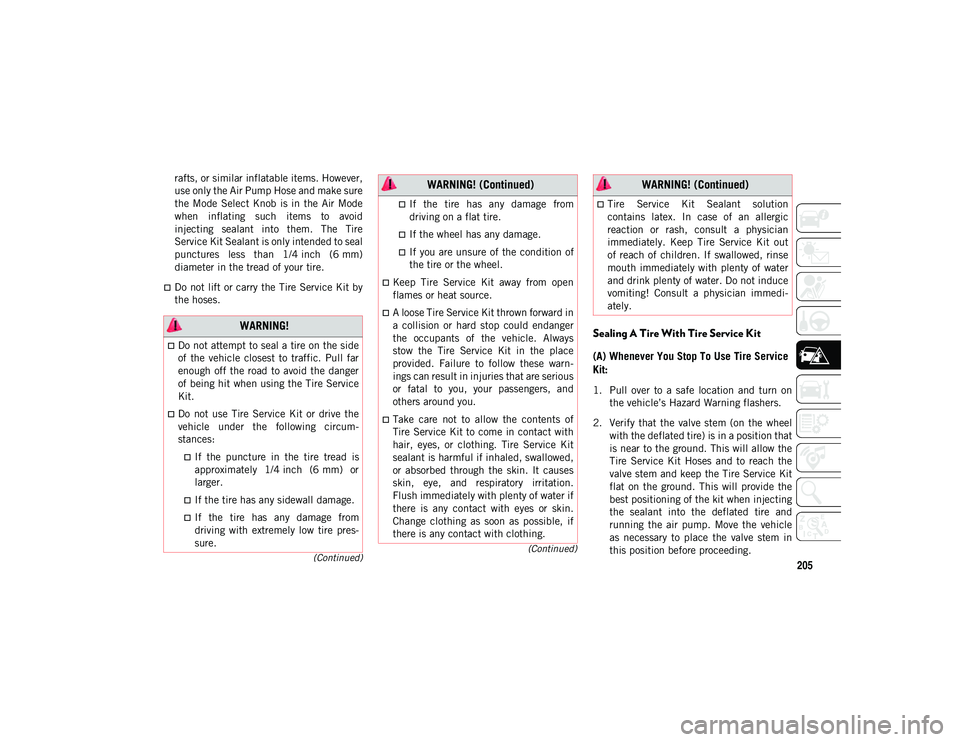
205
(Continued)
(Continued)
rafts, or similar inflatable items. However,
use only the Air Pump Hose and make sure
the Mode Select Knob is in the Air Mode
when inflating such items to avoid
injecting sealant into them. The Tire
Service Kit Sealant is only intended to seal
punctures less than 1/4 inch (6 mm)
diameter in the tread of your tire.
Do not lift or carry the Tire Service Kit by
the hoses.
Sealing A Tire With Tire Service Kit
(A) Whenever You Stop To Use Tire Service
Kit:
1. Pull over to a safe location and turn on the vehicle’s Hazard Warning flashers.
2. Verify that the valve stem (on the wheel with the deflated tire) is in a position that
is near to the ground. This will allow the
Tire Service Kit Hoses and to reach the
valve stem and keep the Tire Service Kit
flat on the ground. This will provide the
best positioning of the kit when injecting
the sealant into the deflated tire and
running the air pump. Move the vehicle
as necessary to place the valve stem in
this position before proceeding.
WARNING!
Do not attempt to seal a tire on the side
of the vehicle closest to traffic. Pull far
enough off the road to avoid the danger
of being hit when using the Tire Service
Kit.
Do not use Tire Service Kit or drive the
vehicle under the following circum -
stances:
If the puncture in the tire tread is
approximately 1/4 inch (6 mm) or
larger.
If the tire has any sidewall damage.
If the tire has any damage from driving with extremely low tire pres-
sure.
If the tire has any damage fromdriving on a flat tire.
If the wheel has any damage.
If you are unsure of the condition ofthe tire or the wheel.
Keep Tire Service Kit away from open
flames or heat source.
A loose Tire Service Kit thrown forward in
a collision or hard stop could endanger
the occupants of the vehicle. Always
stow the Tire Service Kit in the place
provided. Failure to follow these warn -
ings can result in injuries that are serious
or fatal to you, your passengers, and
others around you.
Take care not to allow the contents of
Tire Service Kit to come in contact with
hair, eyes, or clothing. Tire Service Kit
sealant is harmful if inhaled, swallowed,
or absorbed through the skin. It causes
skin, eye, and respiratory irritation.
Flush immediately with plenty of water if
there is any contact with eyes or skin.
Change clothing as soon as possible, if
there is any contact with clothing.
WARNING! (Continued)
Tire Service Kit Sealant solution
contains latex. In case of an allergic
reaction or rash, consult a physician
immediately. Keep Tire Service Kit out
of reach of children. If swallowed, rinse
mouth immediately with plenty of water
and drink plenty of water. Do not induce
vomiting! Consult a physician immedi -
ately.
WARNING! (Continued)
2020_JEEP_CHEROKEE_UG_RHD_UK.book Page 205
Page 208 of 332
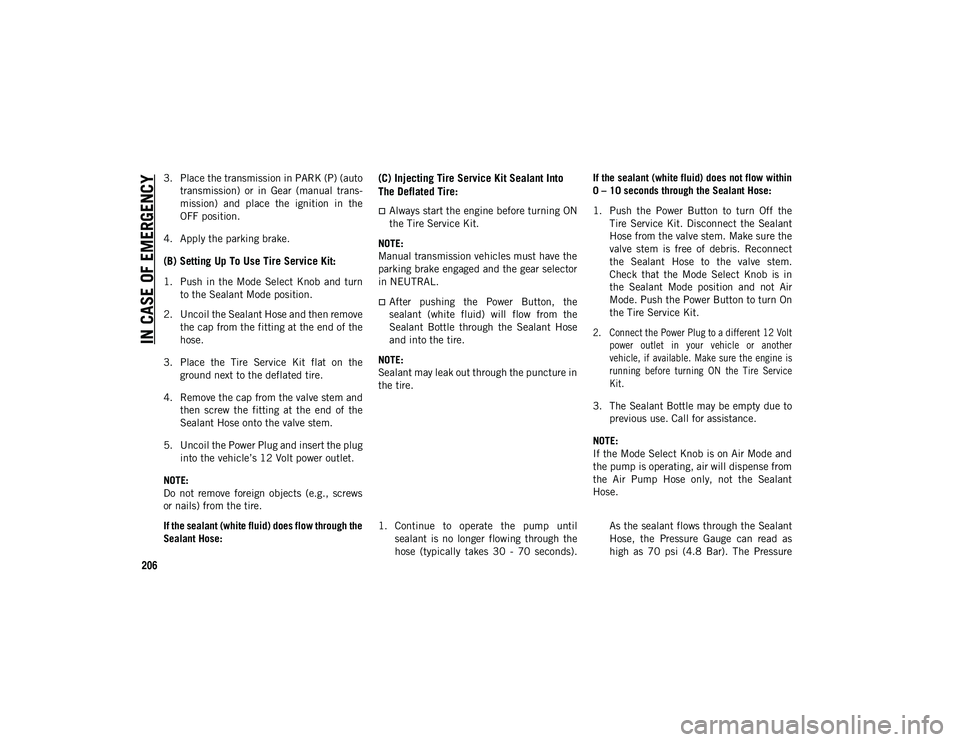
IN CASE OF EMERGENCY
206
3. Place the transmission in PARK (P) (autotransmission) or in Gear (manual trans -
mission) and place the ignition in the
OFF position.
4. Apply the parking brake.
(B) Setting Up To Use Tire Service Kit:
1. Push in the Mode Select Knob and turn to the Sealant Mode position.
2. Uncoil the Sealant Hose and then remove the cap from the fitting at the end of the
hose.
3. Place the Tire Service Kit flat on the ground next to the deflated tire.
4. Remove the cap from the valve stem and then screw the fitting at the end of the
Sealant Hose onto the valve stem.
5. Uncoil the Power Plug and insert the plug into the vehicle’s 12 Volt power outlet.
NOTE:
Do not remove foreign objects (e.g., screws
or nails) from the tire.
(C) Injecting Tire Service Kit Sealant Into
The Deflated Tire:
Always start the engine before turning ON
the Tire Service Kit.
NOTE:
Manual transmission vehicles must have the
parking brake engaged and the gear selector
in NEUTRAL.
After pushing the Power Button, the
sealant (white fluid) will flow from the
Sealant Bottle through the Sealant Hose
and into the tire.
NOTE:
Sealant may leak out through the puncture in
the tire. If the sealant (white fluid) does not flow within
0 – 10 seconds through the Sealant Hose:
1. Push the Power Button to turn Off the
Tire Service Kit. Disconnect the Sealant
Hose from the valve stem. Make sure the
valve stem is free of debris. Reconnect
the Sealant Hose to the valve stem.
Check that the Mode Select Knob is in
the Sealant Mode position and not Air
Mode. Push the Power Button to turn On
the Tire Service Kit.
2. Connect the Power Plug to a different 12 Volt power outlet in your vehicle or another
vehicle, if available. Make sure the engine is
running before turning ON the Tire Service
Kit.
3. The Sealant Bottle may be empty due to previous use. Call for assistance.
NOTE:
If the Mode Select Knob is on Air Mode and
the pump is operating, air will dispense from
the Air Pump Hose only, not the Sealant
Hose.
If the sealant (white fluid) does flow through the
Sealant Hose: 1. Continue to operate the pump until
sealant is no longer flowing through the
hose (typically takes 30 - 70 seconds). As the sealant flows through the Sealant
Hose, the Pressure Gauge can read as
high as 70 psi (4.8 Bar). The Pressure
2020_JEEP_CHEROKEE_UG_RHD_UK.book Page 206
Page 209 of 332
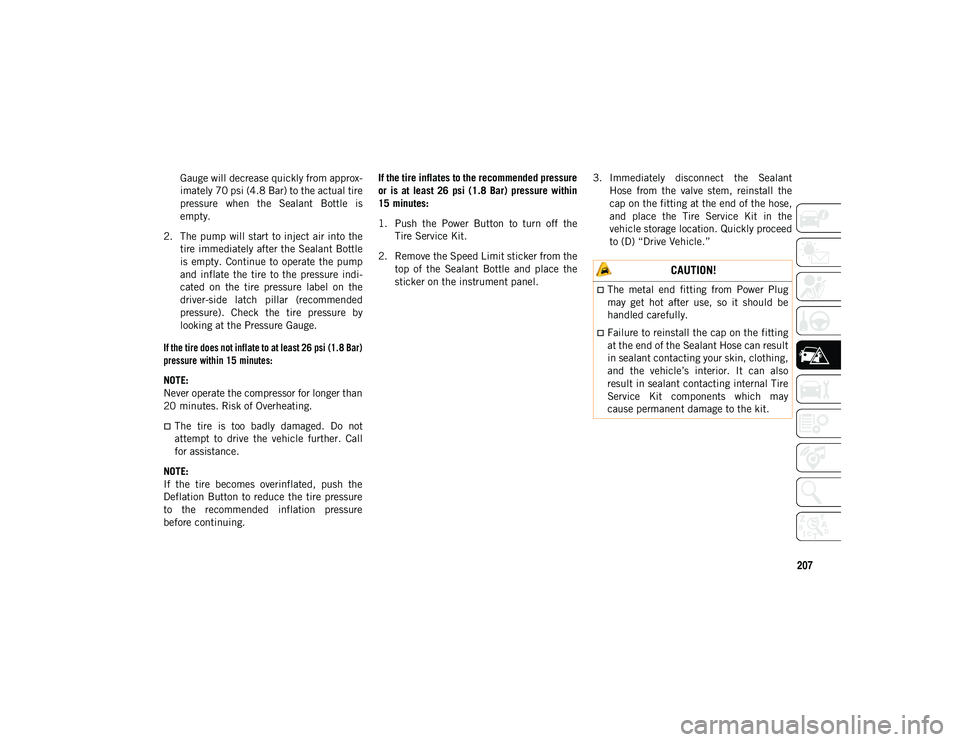
207
Gauge will decrease quickly from approx-
imately 70 psi (4.8 Bar) to the actual tire
pressure when the Sealant Bottle is
empty.
2. The pump will start to inject air into the tire immediately after the Sealant Bottle
is empty. Continue to operate the pump
and inflate the tire to the pressure indi -
cated on the tire pressure label on the
driver-side latch pillar (recommended
pressure). Check the tire pressure by
looking at the Pressure Gauge.
If the tire does not inflate to at least 26 psi (1.8 Bar)
pressure within 15 minutes:
NOTE:
Never operate the compressor for longer than
20 minutes. Risk of Overheating.
The tire is too badly damaged. Do not
attempt to drive the vehicle further. Call
for assistance.
NOTE:
If the tire becomes overinflated, push the
Deflation Button to reduce the tire pressure
to the recommended inflation pressure
before continuing. If the tire inflates to the recommended pressure
or is at least 26 psi (1.8 Bar) pressure within
15 minutes:
1. Push the Power Button to turn off the
Tire Service Kit.
2. Remove the Speed Limit sticker from the top of the Sealant Bottle and place the
sticker on the instrument panel. 3. Immediately disconnect the Sealant
Hose from the valve stem, reinstall the
cap on the fitting at the end of the hose,
and place the Tire Service Kit in the
vehicle storage location. Quickly proceed
to (D) “Drive Vehicle.”
CAUTION!
The metal end fitting from Power Plug
may get hot after use, so it should be
handled carefully.
Failure to reinstall the cap on the fitting
at the end of the Sealant Hose can result
in sealant contacting your skin, clothing,
and the vehicle’s interior. It can also
result in sealant contacting internal Tire
Service Kit components which may
cause permanent damage to the kit.
2020_JEEP_CHEROKEE_UG_RHD_UK.book Page 207
Page 210 of 332
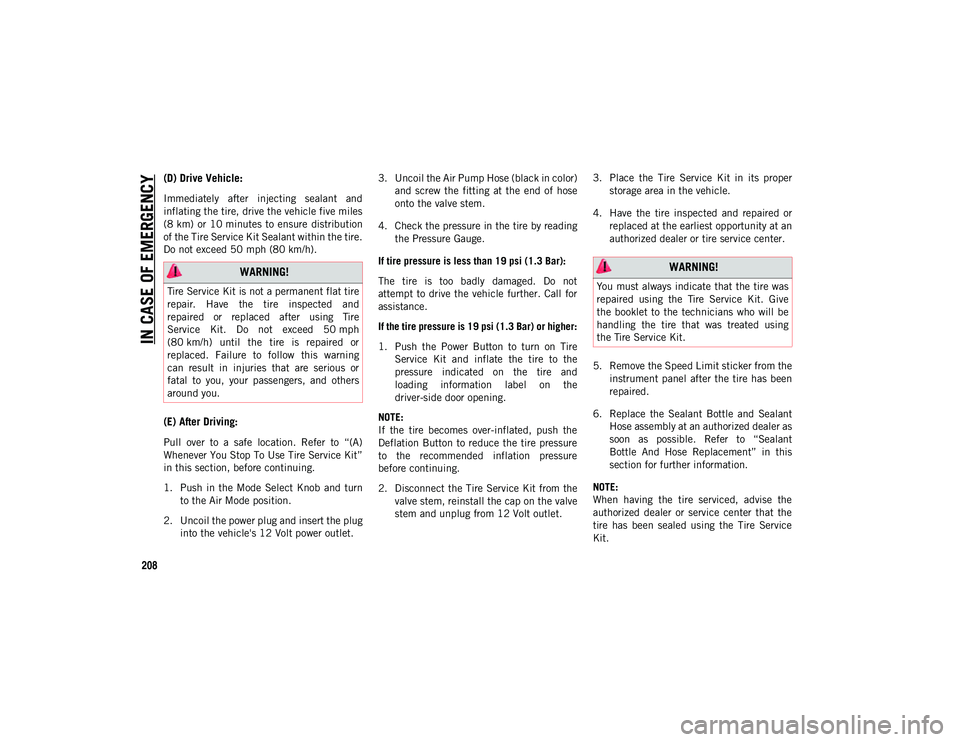
IN CASE OF EMERGENCY
208
(D) Drive Vehicle:
Immediately after injecting sealant and
inflating the tire, drive the vehicle five miles
(8 km) or 10 minutes to ensure distribution
of the Tire Service Kit Sealant within the tire.
Do not exceed 50 mph (80 km/h).
(E) After Driving:
Pull over to a safe location. Refer to “(A)
Whenever You Stop To Use Tire Service Kit”
in this section, before continuing.
1. Push in the Mode Select Knob and turnto the Air Mode position.
2. Uncoil the power plug and insert the plug into the vehicle's 12 Volt power outlet. 3. Uncoil the Air Pump Hose (black in color)
and screw the fitting at the end of hose
onto the valve stem.
4. Check the pressure in the tire by reading the Pressure Gauge.
If tire pressure is less than 19 psi (1.3 Bar):
The tire is too badly damaged. Do not
attempt to drive the vehicle further. Call for
assistance.
If the tire pressure is 19 psi (1.3 Bar) or higher:
1. Push the Power Button to turn on Tire Service Kit and inflate the tire to the
pressure indicated on the tire and
loading information label on the
driver-side door opening.
NOTE:
If the tire becomes over-inflated, push the
Deflation Button to reduce the tire pressure
to the recommended inflation pressure
before continuing.
2. Disconnect the Tire Service Kit from the valve stem, reinstall the cap on the valve
stem and unplug from 12 Volt outlet. 3. Place the Tire Service Kit in its proper
storage area in the vehicle.
4. Have the tire inspected and repaired or replaced at the earliest opportunity at an
authorized dealer or tire service center.
5. Remove the Speed Limit sticker from the instrument panel after the tire has been
repaired.
6. Replace the Sealant Bottle and Sealant Hose assembly at an authorized dealer as
soon as possible. Refer to “Sealant
Bottle And Hose Replacement” in this
section for further information.
NOTE:
When having the tire serviced, advise the
authorized dealer or service center that the
tire has been sealed using the Tire Service
Kit.
WARNING!
Tire Service Kit is not a permanent flat tire
repair. Have the tire inspected and
repaired or replaced after using Tire
Service Kit. Do not exceed 50 mph
(80 km/h) until the tire is repaired or
replaced. Failure to follow this warning
can result in injuries that are serious or
fatal to you, your passengers, and others
around you.
WARNING!
You must always indicate that the tire was
repaired using the Tire Service Kit. Give
the booklet to the technicians who will be
handling the tire that was treated using
the Tire Service Kit.
2020_JEEP_CHEROKEE_UG_RHD_UK.book Page 208